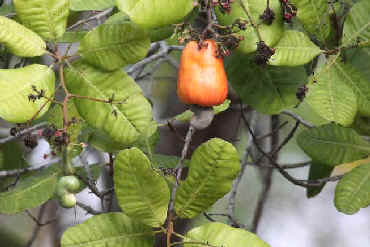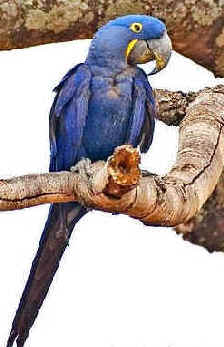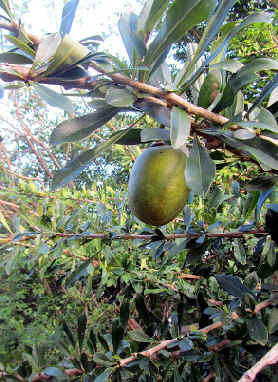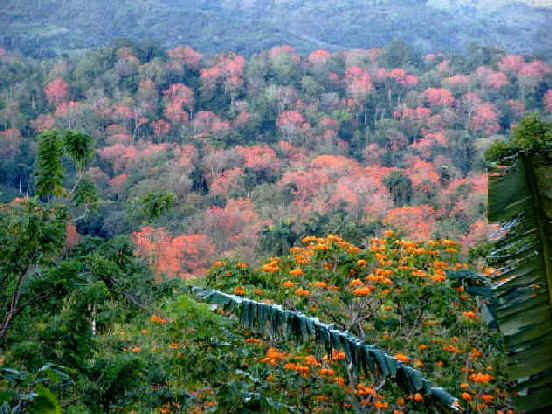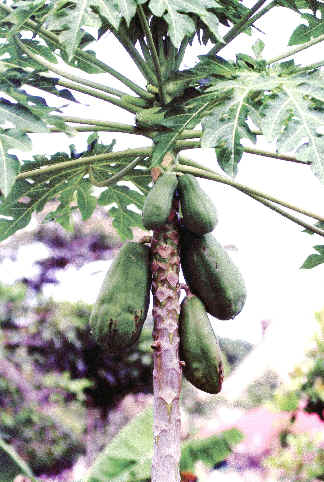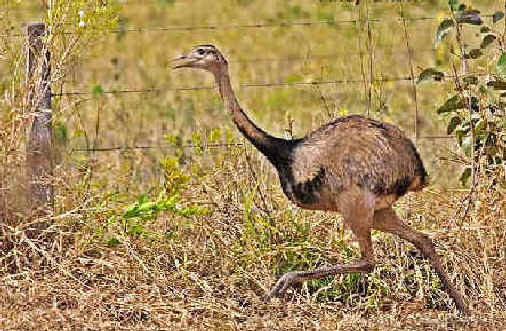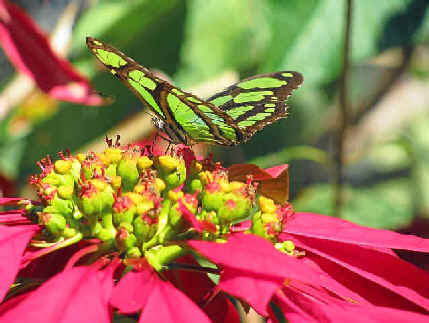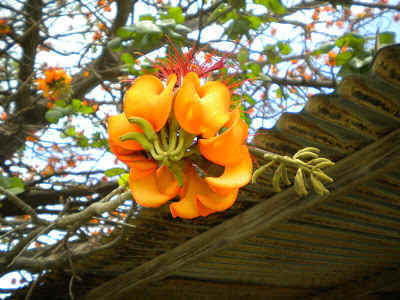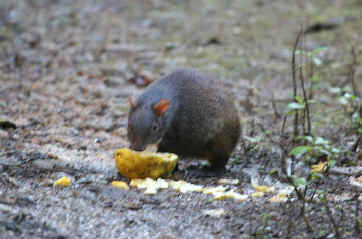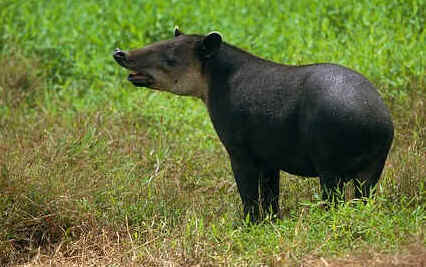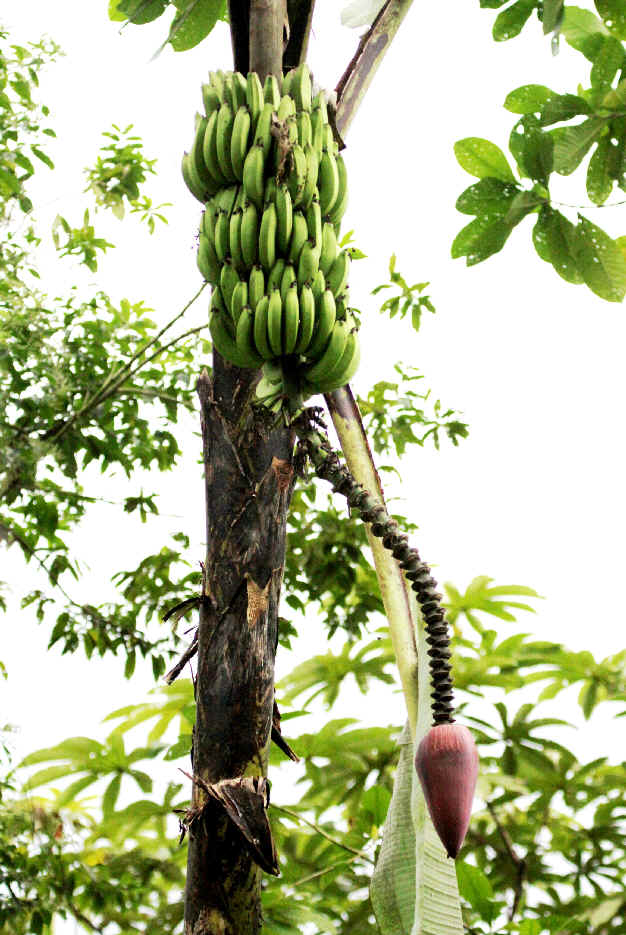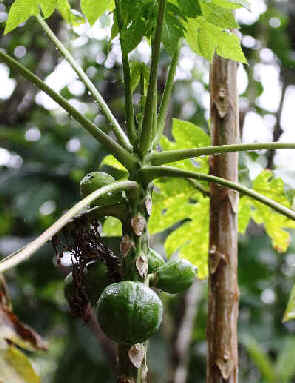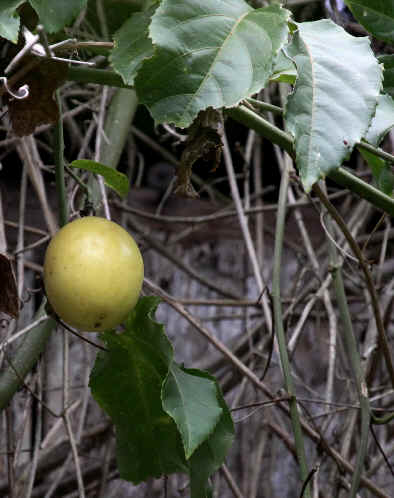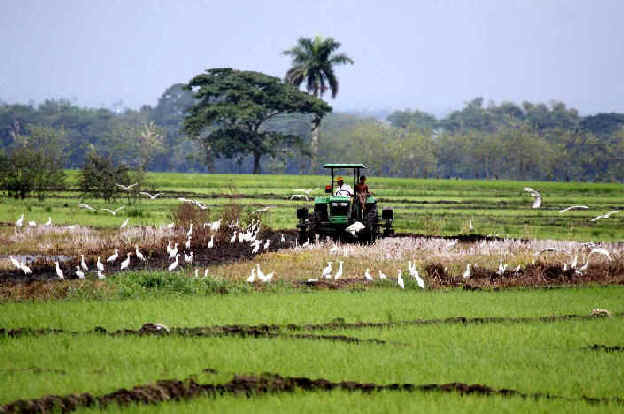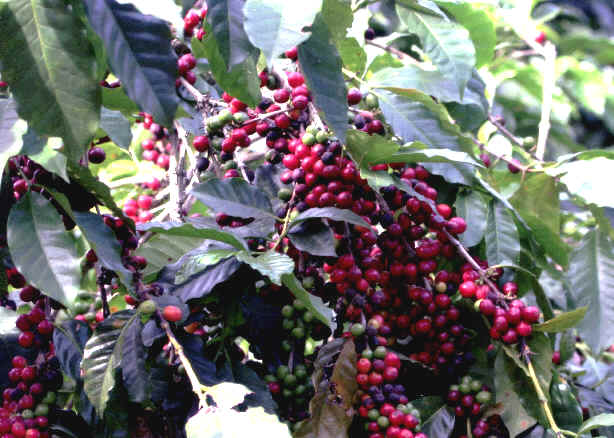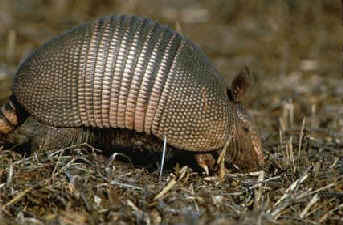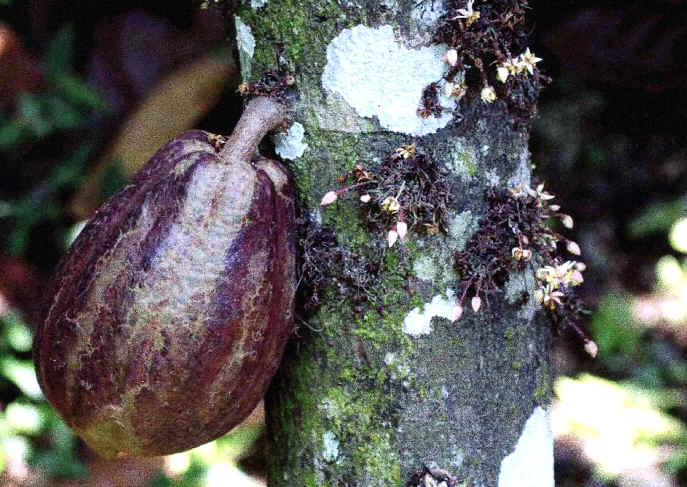
E-mail: font@focusonnature.com
Phone: Toll-free in USA 1-888-721-3555
or 302/529-1876
 |
PO
Box 9021, Wilmington, DE 19809, USA E-mail: font@focusonnature.com Phone: Toll-free in USA 1-888-721-3555 or 302/529-1876 |
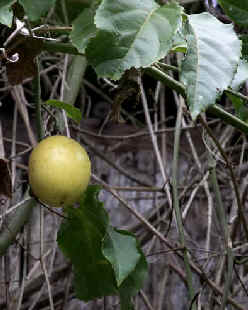
Fruiting
Plants
of
Brazil
and some other
Notable Plants
in that Country
with those during
Focus On Nature Tours
thru 2014
noted with an (*)
during tours in the months of
January, February, March, April,
May, July, November, and December
This List
of Fruiting Plants, and some others, of Brazil
compiled by Armas Hill
Photo at upper right:
PASSIFLORA EDULIS, the PURPLE PASSION FRUIT
photographed during a FONT tour
in April 2014
The fruit becomes purple when ripe.
(photo by Marie Gardner)
There are 22 species of PASSION FRUIT in this list.
There have been 50 FONT birding and nature
tours in Brazil over the years since 1991.
Armas Hill, of Focus On Nature, also made a number of trips to the country
during the previous decade.
Those visits and the tours have been to nearly every part of Brazil, including:
the Amazonian region, southeastern Brazil including the Atlantic Forest, further
inland in Minas Gerais
and in and near Brasilia, in Mato Grosso and Mato Grosso do Sul (including the
Pantanal),
in the area of Iguazu Falls, and as far south as the border with Uruguay in Rio
Grande do Sul.
In these various places, in the big country, as Brazil is, there's an assortment
of varied habitats,
including some tropical, some subtropical, and others temperate.
Of course, the plant life varies
accordingly.
In the list that follows, below the scientific names are names in English and Portuguese (P:).
The families in the list are given (mostly) in alphabetical order, and genera
within them are given alphabetically as well.
Families that are "break-offs" from other families are at times
here still with them, and may be out of alphabetical order.
Links to Plant Families in this List:
ACTINIDIACEAE
- Chinese Gooseberry family
including Kiwi
ANACARDIACEAE - Sumacs
including Cashew, Mango, Hog Plum, Spanish Plum (neither true plums), Mombins
ANNONACEAE - Custard Apples
including Soursop,
Sweetsop, Custard Apple (or "Bull's Heart"), Monkey Banana, Corosol,
Wild Cashina
APOCYNACEAE - Dogbanes including Brazilian Sorva
ARACEAE - Aroids including Ceriman (or "Banana de Macaco")
ARECACEAE,
was PALMAE - Palms
including Coconut Palm, Mauritia
Palm
and referring to the significance of palms for birds such as Macaws
ARAUCARIACEAE - Araucarias
BIGNONIACEAE - Bignonias, Trumpet Creepers including Calabash, Jacaranda trees, Tabebuia ("Ipe") trees
BRASSICADEAE - Mustards (formerly CRUCIFERAE)
BROMELIACEAE - Bromeliads including Pineapple
BURSERACEAE - Torchwoods, or Incense Trees
CACTACEAE
- Cacti including
Dragonfruit
CALOPHYLLACEAE (previously in the CLUSIACEAE, or GUTTIFERAE
family)
including Mammee Apple
CANNABACEAE - Canna (now includes ULMACEAE)
CARICACEAE - Papaya Plants
including Papaya (or Pawpaw)
CARYOCARACEAE (or RHIZOBOLACEAE)
including Brazilian Souari Nut
CELASTRACEAE - Bittersweet, or Staff-vine
CHRYSOBALANACEAE including Cocoplum (both black and red)
CLUSIACEAE - Clusias
COMBRETACEAE - Bush Willows, Combretums, Almond
CONVOLVULACEAE - Morning Glories including Sweet Potato
COSTACEAE - Costus Family including Spiral Gingers
CUCURBITACEAE - Gourd, or Cucumbers
including Watermelon, Winter Squash, Summer Squash (Zucchini), Cantaloupes,
Honeydew, other melons, Balsam Pear
CYCLANTHACEAE including
Panama Hat Plant
EBENACEAE - Ebony and Persimmon including Persimmon
ERICACEAE - Heath including Blueberries
EUPHORBIACEAE - Spurges including Poinsettia, Rubber Tree
FABACEAE - Legume,
or Pea or Bean Family (includes CAESALPINIOIDEAE, the Carob Plants, and
MIMOSOIDEAE, the Mimosa Plants)
including Pernambuco (tree for making violins, the world's best), Tonka Bean Tree, Inga trees,
Ice Cream Bean
FAGACEAE - Beech
family including
Spanish Chestnut
HUMIRIACEAE
ICACINACEAE
JUGLANDACEAE - Walnuts including Pecan
LAMIACEAE, or LABIATAE - Mints including Amazonian Basil
LAURACEAE - Laurel including Avocado
LECYTHIDACEAE - Brazil Nut plants and allies including Brazil Nut Tree, Cannonball Tree, Monkey Pot Tree
LYTHRACEAE - Loosestrifes including Pomegranate
MALPIGHIACEAE including Peanut Butter Fruits, Shoemaker's Tree, Barbados Cherry
MALVACEAE - Mallows (includes BOMBACACEAE, the Cotton Tree Plants) including Saba Nut
MELASTOMATACEAE - Melastomes including Mess Apple (or "Araca de Anta", "food of the Tapir")
MENISPERMACEAE
MORACEAE - Mulberry plants
including Breadfruit,
Jackfruit, Fig, Strangler Fig, Mulberries
MUNTINGIACEAE
including Capulin
MUSACEAE - Banana plants, Heliconias including Banana, Plantain
MYRTACEAE - Myrtles including Guavas, Flying Saucer Fruit, Brazil Cherry, Rainforest Plum, Brazilian Grape, Rumberry, Lilly Pilly, Water Apple, Mountain Apple, Java Plum, Java Apple, Brush Cherry
NYCTAGINACEAE - Four O' Clocks including Bougainvillea
OLACACEAE including Hog Plum (not the same fruit as in ANACARDIACEAE)
ONAGRACEAE - Willowherb, Evening Primrose including Fuchsias
OXALIDACEAE including Star Fruit
PASSIFLORACEAE - Passionflowers
PHYLLANTACEAE
including Oriental
Gooseberries
POACEAE (or GRAMINEAE) - Grasses
including Sugarcane, Rice, Corn
PONTEDERIACEAE - Water Hyacinth, Pickerel-weed
PROTEACEAE - Macadamia and allies including Macadamia Nuts
RHAMNACEAE - Buckthorns
including Chinese Raisin,
Jujubes
RHIZOPHORACEAE - Mangroves and allies
ROSACEAE - Rose including Quince, Loquat, Strawberry, Apple, Apricot, Italian Plum, Sweet Almond, Peach, Nectarine, Japanese Plum, Pear, Apple Pear, Raspberries, Blackberries
RUBIACEAE - Madders including Coffee, Genips, Spanish Tamarind
RUTACEAE - Citrus, or Rue including Lime, Sour Orange, Mandarin, Sweet Limes, Lemon (a hybrid), Citron, Grapefruit (a hybrid), Tangerine, Sweet Orange, Kumquats
SALICACEAE - Willows including Pipewood (or Wild Honey Tree), Kei Apple, Governor's Plum, Batoko Plum
SANTALACEAE - Sandalwoods (includes VISCACEAE, Mistletoes)
SAPINDACEAE - Soapberry family including Aki (or Akee), Guarana (used in a popular Brazilian soft drink)
SAPOTACEAE - Sapote plants including Star Apple, Massarandubas, Armadillo Fruit, Miracle Fruit
SOLANACEAE - Nightshades including Tree Tomato
STERCULIACEAE - Cacao plants
including Cacao (or Cocoa)
URTICACEAE - Nettles
including Cecropia trees, Amazon Tree Grape
VERBENACEAE - Vervains, Verbanas
VITACEAE - Grapes
including various cultivated grapes
ORCHIDS in
Brazil are in:
WILD
ORCHIDS OF THE AMERICAS
AN
ALPHABETICAL DIRECTORY OF PLANT GENERA IN THIS WEBSITE NOTING FAMILIES
Codes:
BR:
species that occurs in Brazil either as a native or cultivated plant
(every species in this list,
those color-coded blue are fruits, those red are other plants)
Other Links:
Information about
Upcoming FONT Birding & Nature Tours:
in the Caribbean in
Central America in
South America (Brazil and Ecuador)
or by month in: 2015
or:
by geographic locations worldwide
Lists and Photo Galleries in this Website of Other Nature:
Birds in: the Caribbean Central America South America (Brazil) South America (Ecuador)
A list and Photo Gallery of Hummingbirds in 2 parts
Mammals: the Caribbean Central America South America
Butterflies
and Moths in: the
Caribbean
Central America
South America
Other Lists and Photo Galleries in this website relating to
Plants:
Tropical Plants on West Indian Islands in the Caribbean WILD ORCHIDS OF THE AMERICAS
Wildflowers & Other Plants in Texas Wildflowers & Other Plants in Eastern North America
Desert Plants of the Southwest US & northern Mexico
Northern Plants in Alaska, Iceland, & the mountains of Hokkaido, Japan
(with some notes about medicinal and edible plants)
Links to Other
Lists & Photo Galleries of Plants Directory of Photos in this Website
![]()
Books that have been sources for this list include:
"Aves Brasileiras e Plantas que as Atraem" by Johan Dalgas
Frisch and Christian Dalgas Frisch, 2005
"Brazil, Amazon and Pantanal - the Ecotraveler's Wildlife Guide"
by David Pearson and Les Beletsky, 2002
"Brazilian Fruits and Cultivated Exotics" by Harri Lorenzi,
Luis Bacher, Marco Lacerda, Sergio Sartori, 2006
"Hummingbirds, a Life-size Guide to Every Species" by Michael
Fogden, Marianne Taylor, and Sheri Williamson, 2014
"Tropical Plants of the World" by Jens Rohwer, 2002
A List of
Tropical Plants
of the Americas:
Family
ACTINIDIACEAE (Chinese Gooseberry family)
Genus
ACTINIDIA
